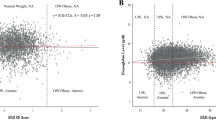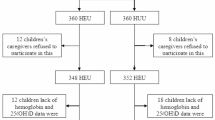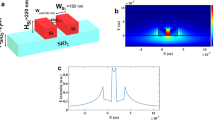Abstract
Background/Objectives:
The use of multimicronutrient (MMN) supplementation to reduce the burden of anaemia in non-pregnant women of reproductive age has been little studied, particularly in Africa. The objective of the study was to evaluate haematological outcomes in non-pregnant, rural Gambian women of reproductive age, receiving daily MMN supplements for 1 year.
Subjects/Methods:
The study in 293 women aged from 17 to 45 years old was nested within a double-blind, randomized placebo-controlled trial of periconceptional MMN supplementation [ISRCTN 13687662], using the United Nations International Multiple Micronutrient Preparation (UNIMMAP), received daily for 1 year or until conception. Red cell parameters and free erythrocyte protoporphyrin concentration were measured at baseline and after 12 months in those women who did not conceive.
Results:
Anaemic women (haemoglobin concentration <12 g per 100 ml) were more likely to be older and in economic deficit at baseline. Mean change in haemoglobin concentration was +0.6±1.4 g per 100 ml in the intervention arm and −0.2±1.2 g per 100 ml in the placebo arm (P<0.001). After supplementation with MMN, the relative risk of anaemia (<12 g per 100 ml) was 0.59 (0.46, 0.76) compared with placebo. Anaemic subjects at baseline showed an increase in mean haemoglobin from 10.6 g per 100 ml to 11.8 g/l (P<0.001) after MMN supplementation.
Conclusions:
MMN supplementation should be considered as a strategy for improving the micronutrient and haematological status of non-pregnant women of reproductive age.
This is a preview of subscription content, access via your institution
Access options
Subscribe to this journal
Receive 12 print issues and online access
$259.00 per year
only $21.58 per issue
Buy this article
- Purchase on SpringerLink
- Instant access to full article PDF
Prices may be subject to local taxes which are calculated during checkout


Similar content being viewed by others
References
Ahmed F, Khan MR, Akhtaruzzaman M, Karim R, Marks GC, Banu CP et al. (2005). Efficacy of twice-weekly multiple micronutrient supplementation for improving the hemoglobin and micronutrient status of anemic adolescent schoolgirls in Bangladesh. Am J Clin Nutr 82, 829–835.
Allen LH (2000). Anemia and iron deficiency: effects on pregnancy outcome. Am J Clin Nutr 71, 1280S–1284S.
Angeles-Agdeppa I, Schultink W, Sastroamidjojo S, Gross R, Karyadi D (1997). Weekly micronutrient supplementation to build iron stores in female Indonesian adolescents. Am J Clin Nutr 66, 177–183.
Anya SE (2004). Seasonal variation in the risk and causes of maternal death in the Gambia: malaria appears to be an important factor. Am J Trop Med Hyg 70, 510–513.
Bartley KA, Underwood BA, Deckelbaum RJ (2005). A life cycle micronutrient perspective for women's health. Am J Clin Nutr 81, 1188S–1193S.
Bates CJ, Villard L, Prentice AM, Paul AA, Whitehead RG (1984). Seasonal variations in plasma retinol and carotenoid levels in rural Gambian women. Trans R Soc Trop Med Hyg 78, 814–817.
Billewicz WZ, McGregor IA (1981). The demography of two West African (Gambian) villages, 1951–75. J Biosoc Sci 13, 219–240.
Brabin BJ, Hakimi M, Pelletier D (2001). An analysis of anemia and pregnancy-related maternal mortality. J Nutr 131, 604S–614S; discussion 614S–615S.
Breckenridge MA, Okpanachi E (1976). The erythrocyte sedimentation rate in healthy North Nigerian university students. Afr J Med Med Sci 5, 221–227.
Brigden ML (1999). Clinical utility of the erythrocyte sedimentation rate. Am Fam Physician 60, 1443–1450.
Christian P, Khatry SK, Katz J, Pradhan EK, LeClerq SC, Shrestha SR et al. (2003). Effects of alternative maternal micronutrient supplements on low birth weight in rural Nepal: double blind randomised community trial. BMJ 326, 571.
Fawzi WW, Msamanga GI, Urassa W, Hertzmark E, Petraro P, Willett WC et al. (2007). Vitamins and perinatal outcomes among HIV-negative women in Tanzania. N Engl J Med 356, 1423–1431.
Gabay C, Kushner I (1999). Acute-phase proteins and other systemic responses to inflammation. N Engl J Med 340, 448–454.
Huffman SL, Shumann J, Zehner ER (1998). The case for promoting multiple vitamin/mineral supplements for women of reproductive age in developing countries. The LINKAGES Project.
Hyder SM, Haseen F, Khan M, Schaetzel T, Jalal CS, Rahman M et al. (2007). A multiple-micronutrient-fortified beverage affects hemoglobin, iron, and vitamin A status and growth in adolescent girls in rural Bangladesh. J Nutr 137, 2147–2153.
Hyder SM, Persson LA, Chowdhury M, Lonnerdal BO, Ekstrom EC (2004). Anaemia and iron deficiency during pregnancy in rural Bangladesh. Public Health Nutr 7, 1065–1070.
Kaestel P, Michaelsen KF, Aaby P, Friis H (2005). Effects of prenatal multimicronutrient supplements on birth weight and perinatal mortality: a randomised, controlled trial in Guinea-Bissau. Eur J Clin Nutr 59, 1081–1089.
Kanfer EJ, Nicol BA (1997). Haemoglobin concentration and erythrocyte sedimentation rate in primary care patients. J R Soc Med 90, 16–18.
Leenstra T, Kariuki SK, Kurtis JD, Oloo AJ, Kager PA, Ter Kuile FO (2007). The effect of weekly iron and vitamin A supplementation on hemoglobin levels and iron status in adolescent schoolgirls in western Kenya. Eur J Clin Nutr.
Medical Research Council (1998). MRC Guidelines for Good Clinical Practice in Clinical Trials. London: Medical Research Council.
Moriarty-Craige SE, Ramakrishnan U, Neufeld L, Rivera J, Martorell R (2004). Multivitamin-mineral supplementation is not as efficacious as is iron supplementation in improving hemoglobin concentrations in nonpregnant anemic women living in Mexico. Am J Clin Nutr 80, 1308–1311.
Owens S, Fall CH (2008). Consequences of poor maternal micronutrition before and during early pregnancy. Trans R Soc Trop Med Hyg 102, 103–104.
Powers HJ, Bates CJ (1987). Micronutrient deficiencies in the aetiology of anaemia in a rural area in The Gambia. Trans R Soc Trop Med Hyg 81, 421–425.
Reveiz L, Gyte GM, Cuervo LG (2007). Treatments for iron-deficiency anaemia in pregnancy. Cochrane Database Syst Rev CD003094.
Sandstrom B (2001). Micronutrient interactions: effects on absorption and bioavailability. Br J Nutr 85 (Suppl 2), S181–S185.
Schim van der Loeff MF, Sarge-Njie R, Ceesay S, Awasana AA, Jaye P, Sam O et al. (2003). Regional differences in HIV trends in The Gambia: results from sentinel surveillance among pregnant women. AIDS 17, 1841–1846.
Stoltzfus RJ (2003). Iron deficiency: global prevalence and consequences. Food Nutr Bull 24, S99–103.
Topley E (1968). Common anaemia in rural gambia. II. Iron deficiency anaemia among women. Trans R Soc Trop Med Hyg 62, 595–601.
UNICEF/WHO/UNU (1999). Composition of a multi-micronutrient supplement to be used in pilot programmes among pregnant women in developing countries. Report of an UNICEF/WHO/UNU workshop. UNICEF: New York
WHO/UNU/UNICEF (2001). Iron Deficiency Anaemia Assessment, Prevention and Control: A Guide for Programme Managers. Geneva: World Health Organisation
West Jr KP, Katz J, Khatry SK, LeClerq SC, Pradhan EK, Shrestha SR et al. (1999). Double blind, cluster randomised trial of low dose supplementation with vitamin A or beta carotene on mortality related to pregnancy in Nepal. The NNIPS-2 Study Group. BMJ 318, 570–575.
Acknowledgements
The authors thank the PMMST field team, especially Ms Fatou Sossey (Senior Midwife) and Mr Baba Jobarteh (Field Supervisor) and Dr Sophie Moore (Head of Station, MRC Keneba) for their logistical support to the project. The study was funded from the programme grant to the MRC International Nutrition Group, London School of Hygiene and Tropical Medicine.
Author information
Authors and Affiliations
Corresponding author
Rights and permissions
About this article
Cite this article
Gulati, R., Bailey, R., Prentice, A. et al. Haematological effects of multimicronutrient supplementation in non-pregnant Gambian women. Eur J Clin Nutr 63, 970–977 (2009). https://doi.org/10.1038/ejcn.2009.11
Received:
Revised:
Accepted:
Published:
Issue date:
DOI: https://doi.org/10.1038/ejcn.2009.11
Keywords
This article is cited by
-
Perspectives on the design and methodology of periconceptional nutrient supplementation trials
Trials (2016)
-
Effect of supplementation of drumstick (Moringa oleifera) and amaranth (Amaranthus tricolor) leaves powder on antioxidant profile and oxidative status among postmenopausal women
Journal of Food Science and Technology (2014)



